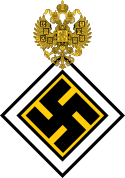You can help expand this article with text translated from the corresponding article in Russian. (January 2013) Click [show] for important translation instructions.
|
All-Russian Fascist Party Russian: Всероссийская фашистская партия | |
|---|---|
 | |
| Abbreviation | VFP |
| Secretary-general | Konstantin Rodzaevsky |
| Founder | Nikolai Nikiforov |
| Founded | 26 May 1931 |
| Dissolved | 1 July 1943 |
| Preceded by | Russian Fascist Organization[1] |
| Headquarters | Harbin, Manchukuo |
| Newspaper | Nash Put'[2] |
| Women's wing | Russian Women's Fascist Movement |
| Youth wings | Fascist Union of Youth[3] Union of Young Fascists – Vanguard Union of Fascist Little Ones |
| Membership | |
| Ideology | Russian clerical fascism[5] |
| Political position | Far-right |
| Religion | Russian Orthodox Christianity |
| Political alliance | All-Russian Fascist Party (1934)[8][9] |
| Colours | Black Gold White |
| Slogan | Бог, Нация, Труд ("God, Nation, Labour") |
| Anthem | Поднимайтесь, братья, с нами! ("Come up, brothers, with us!")[10] |
| Party flag | |
  | |
The All-Russian Fascist Party[a] (VFP),[b] and from 1937 onwards the Russian Fascist Union,[c] was a minor Russian émigré movement that was based in Manchukuo during the 1930s and 1940s.
- ^ E. Oberländer, 'The All-Russian Fascist Party', Journal of Contemporary History, Vol. 1, No. 1. (1966), pp. 158–173
- ^ The Russian Fascists: Tragedy and Farce in Exile, 1925-1945 by John J. Stephan
- ^ Русские фашисты в Китае
- ^ Center. archive of the FSB of the Russian Federation. Investigation case N-18765 in relation to Semyonov GM, Rodzaevsky KV and others T. 10, ld 145-206.
- ^ a b c d e Oberländer, Erwin (January 1966). "The All-Russian Fascist Party". Journal of Contemporary History. 1 (1): 158–173. doi:10.1177/002200946600100110. JSTOR 259654. S2CID 159295789.
- ^
Badie, Bertrand; Berg-Schlosser, Dirk; Morlino, Leonardo, eds. (7 September 2011). International Encyclopedia of Political Science. SAGE Publications (published 2011). ISBN 9781483305394. Retrieved 9 September 2020.
[...] fascist Italy [...] developed a state structure known as the corporate state with the ruling party acting as a mediator between 'corporations' making up the body of the nation. Similar designs were quite popular elsewhere in the 1930s. The most prominent examples were Estado Novo in Portugal (1932-1968) and Brazil (1937-1945), the Austrian Standestaat (1933-1938), and authoritarian experiments in Estonia, Romania, and some other countries of East and East-Central Europe.
- ^ Stephan, John J. (1978). The Russian Fascists: Tragedy and Farce in Exile, 1925-1945. New York: Harper & Row. p. 56. ISBN 0060140992.
- ^ Winter, Barbara. The Most Dangerous Man in Australia Archived 2016-04-25 at the Wayback Machine. Carindale, Qld: IP (Interactive Publications), 2010. p. 131
- ^ The Russian Fascists: Tragedy and Farce in Exile, 1925—1945 by John J. Stephan, p. 160
- ^ Anthem of the Russian Fascist Party "Flags up!"
Cite error: There are <ref group=lower-alpha> tags or {{efn}} templates on this page, but the references will not show without a {{reflist|group=lower-alpha}} template or {{notelist}} template (see the help page).